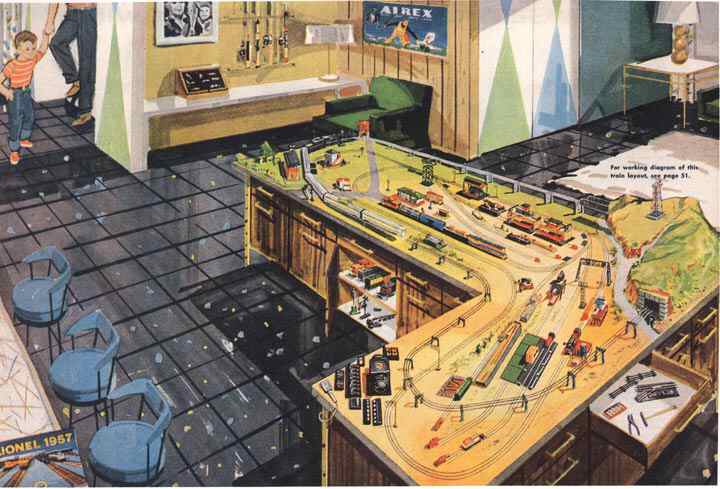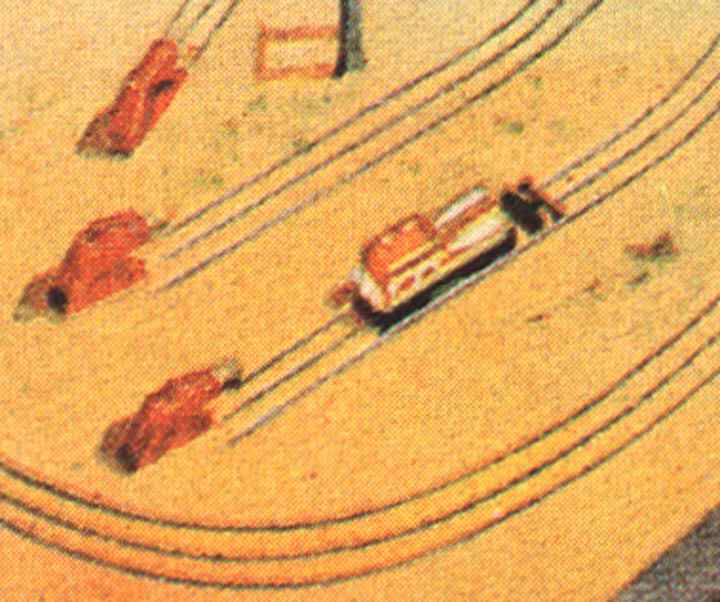1957 Dream Layout
By Joseph H. Lechner
Ask collectors to name the greatest toy train wishbook of all time, and you’re sure to get more than a few votes for Lionel’s 1957 consumer catalog. It was a great year for 3-rail trains. The Lion offered more sets, and a greater variety of cars and accessories, than ever before. Outstanding new items in 1957 included Super “O” track, the Norfolk and Western “J” class 4-8-4, and the coveted Canadian Pacific passenger set. In retrospect, 1957 turned out to be the last “pure” Lionel train line. In subsequent postwar catalogs, 3-rail trains competed for attention with HO trains, race cars, rockets, atomic energy paraphernalia, phonographs, and science kits.
The purpose of any catalog is to make prospective customers want your merchandise. In this respect, Lionel’s 1957 issue succeeds brilliantly. Robert Sherman’s artwork makes the trains seem bigger than life. The illustrations show you how each set would look when running on a well-equipped layout. No; better yet, they portray the idealized world that you will create in your imagination while you play with Lionel trains.
Lionel catalog art usually presented toys as if they were full-sized trains. The illustrator gave them a route to run on, places to go, freight and passengers to deliver, and enthusiastic spectators to watch them pass by. When you see the #2331 Virginian on the page, you imagine that you are standing at trackside somewhere in Appalachia watching a real Fairbanks-Morse Trainmaster roar upgrade. No full-sized objects are in the picture to spoil the illusion. You rarely see a transformer, a control panel or the boards at the edge of the layout; you never see walls, windows or household objects.
A remarkable exception is this scene from the back cover of Lionel’s 1957 catalog. It stands alone among postwar illustrations by showing us the complete setting of a home layout, including furniture, décor, and hobby items not directly related to model railroading. What do you notice when you view this illustration?
A collector of premium postwar trains will notice that the Norfolk and Western steam locomotive seems to be the more desirable long-stripe version. This particular Class J is pulling a set of 2530 series streamlined passenger cars. Lionel never cataloged #746 in a passenger set, but N&W designed its J’s with fast passenger service in mind, so the consist is certainly prototypical. A collector would also immediately spot that rare Jersey Central Trainmaster rolling past the station. High-horsepower Fairbanks Morse diesels were used primarily for freight, although Lionel cataloged #2341 only in a passenger set. Boxcar aficionados would carefully inspect that 6464-300 closely to ascertain that it is the more common solid-yellow-door type rather than the scarce variation with a green stripe through the door. They will wish the right side of the car were completely visible because they’re wondering whether the Rutland herald is outlined in green or solid green.
An operator who is familiar with O 3-rail trains might think that the #2341 is underemployed hauling a four-car freight. The twin-motored Trainmaster was one of Lionel’s best pullers, easily capable of handling a twelve-car train. Surely it belongs on the main line. An operator will wonder how that #3927 track cleaning car is going to get off its siding, since it has no coupler in the direction facing the locomotive. He will also worry what will happen to the #602 Seaboard if it continues on its present route and runs smack into a steel trestle.
Someone who is familiar with real railroads may wonder why the #415 fueling station and #352 icing station are located along the main line, where diesels and reefers would obstruct traffic as they’re being serviced. Why does the #450 signal bridge span a yard track that leads to the transfer table? Most railroads would have used a dwarf signal in that location. Why is the water tank located at the start of a 5% upgrade—and on a sharp curve to boot? Even the mighty #746 would have difficulty restarting its train after pausing for water there.
Visitors who are not particularly knowledgeable about toy trains would still appreciate the finished appearance of the layout. No bare plywood can be seen on this table top. This layout looks like the real world in miniature. Every square inch is appropriately landscaped with grass, trees, mountains, a river, highways, and structures.
Even a guest with only passing interest in trains would surely notice the layout’s attractive underpinnings. A far cry from the unpainted sawhorses and 4×8 plywood that are usually depicted in postwar catalogs, this train table is a piece of fine furniture with cupboards, drawers, mahogany panels, and polished brass fittings. Who ever said that a model railroad had to be an interior decorator’s eyesore?
What’s more, this layout is the centerpiece of a recreation room that is obviously used and enjoyed by every member of the family. Even though it is obviously in the basement, this is an inviting, fully-finished basement. The tiled floor has been cleaned and waxed recently, and it really shines. The walls are tastefully decorated with paneling and wallpaper. This room is much better illuminated than most basements. Even the descending stairway has been enclosed with painted drywall.
There are plenty of accommodations here for activities other than railroading. The upholstered furniture, lamp, end table and throw rug provide a place for quiet conversation or reading. The bar and stools at left suggest that this family has enjoyed many a meal or snack there. That alcove at the back houses Dad’s fishing rods and lures, and shows off a photo of his prize catch. The artist made sure to include a commercial for Airex, a line of fishing tackle that was marketed by Lionel in the late 1950s. Viewing the same scene today, we might assume the Airex poster was part of a collection of Lionel memorabilia.
This catalog art from Lionel’s golden era still offers valuable lessons for collectors / operators today. Careful attention to scenery, benchwork and décor will make your train room a more attractive place for family members and visitors.










